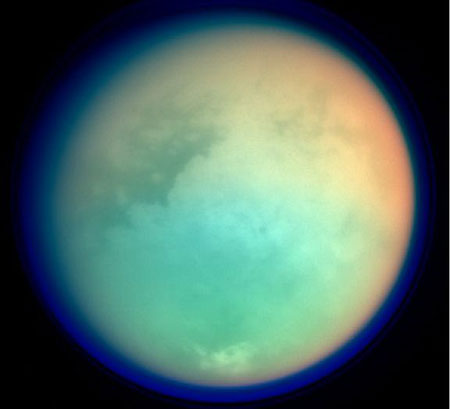Earth and Titan are surprisingly similar
Some environmental conditions on Saturn's Titan satellite are very similar to Earth in the beginning of life. The new discovery has just been published in two works presented at the International Cosmology Association (IAU), which is taking place in Rio de Janeiro.
Geologist Rosaly Lopes of the fuel laboratory pushed the US space agency (NASA) to confirm ' The surface of the Earth and Titan are surprisingly similar. In fact, this satellite is more similar to Earth than any other solar system object despite the huge temperature difference '.
According to researcher Robert Nelson of NASA's jet propulsion laboratory, Titan satellite has sparked a great interest in science because of its dense atmosphere and the only extraterrestrial object. So far there are reservoirs of liquid on the surface .
These conclusions are the result of the Cassini-Huygens space exploration ship project, a joint project between NASA, the European aerospace agency (ESA) and the Italian aerospace agency (ASI).

Titan Satellite (Photo: NASA)
Currently, Cassini-Huygens radar has captured images of about a third of Saturn's ' moon ' surface and the team is learning more about the changing seasons between Titan.
The similarity between Titan and Earth is that it has sand dunes, formed from cold winds, and rich mountain terrain . Mountain ranges at Titan may have been formed from seismic and tectonic activities when the satellite's crust shrinks into a frozen state (unlike the Earth's crust that is still in a moving phase). ).
Two newly published works also demonstrate the activity of ' cold volcanoes ' at Titan. Unlike the hot magma mechanism on Earth, scientists believe that ' cold volcanoes ' in Titan erupt ice and ammonia gas.
- Summer clouds on Saturn's Titan satellite
- Winter appears on Saturn's Titan moon
- New computer model about Moon Titan
- Earth creatures migrate to Titan planet?
- Titan moon can nourish life
- Saturn's moon wave is only 1 centimeter tall
- The new discovery shook the hypothesis of life on Titan
- Titan has more oil than Earth
- Cassini ships Titan's signal to Earth
- Detecting cell membrane material on Titan moon
- Titan Saturn Moon: 1,000 years a rain
- People can fly like birds on Saturn moon
 Van Allen's belt and evidence that the Apollo 11 mission to the Moon was myth
Van Allen's belt and evidence that the Apollo 11 mission to the Moon was myth The levels of civilization in the universe (Kardashev scale)
The levels of civilization in the universe (Kardashev scale) Today Mars, the sun and the Earth are aligned
Today Mars, the sun and the Earth are aligned The Amazon owner announced a secret plan to build a space base for thousands of people
The Amazon owner announced a secret plan to build a space base for thousands of people NASA selects partners to explore Saturn's moon Titan
NASA selects partners to explore Saturn's moon Titan  3 hypotheses about the missing Titan submarine in the Atlantic Ocean
3 hypotheses about the missing Titan submarine in the Atlantic Ocean  Titan submarine crushed, 5 people on board died
Titan submarine crushed, 5 people on board died  If the Titans in 'Attack on Titan' Really Existed: Could Humanity Survive?
If the Titans in 'Attack on Titan' Really Existed: Could Humanity Survive?  Mysterious moon has hundreds of times more 'poisonous gas' than Earth: What if it catches on fire?
Mysterious moon has hundreds of times more 'poisonous gas' than Earth: What if it catches on fire?  Revealing an alien world with a landscape similar to Earth
Revealing an alien world with a landscape similar to Earth 